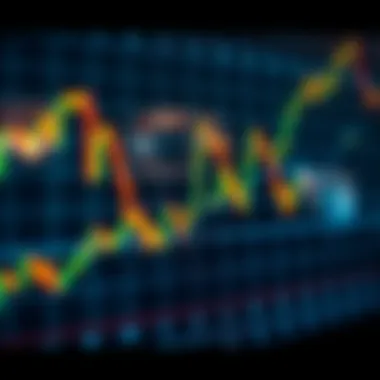Analyzing XLE Stock Price Charts for Investors


Intro
Understanding stock price charts can often seem like trying to read hieroglyphics—filled with symbols and lines whose meanings aren’t immediately clear. For XLE, the Energy Select Sector SPDR Fund, these charts hold vital information that can influence investment strategies. An analytical approach towards these visuals not only illuminates historical performance but also provides clues about market movements, driven by external factors like economic reports and geopolitical events.
Investors, whether seasoned or just stepping into the investment arena, find that deciphering stock price charts offers critical insights. They reveal trends, highlight potential resistance and support levels, and underline periods of volatility that could signal an opportunity—or a risk. Each squiggly line and plotted point isn't just a string of data; it’s a narrative of the market’s relationship with energy stocks.
As we delve into this analysis, we will shed light on fundamental terminology and offer strategic advice aimed at enhancing the investment acumen of our readers. To fully grasp the nuances of stock chart analysis, we will first define essential concepts that will serve as the backbone for our exploration.
Investment Dictionary
Definition of Key Terms
When navigating the waters of XLE stock price charts, it’s critical to be familiar with key terms that will pop up frequently. Here’s a look at some foundational terminology:
- Price Action: This term describes the movement of a stock's price over time and is crucial for chart analysis.
- Support and Resistance: These refer to price levels that act as barriers—the support level indicates where the price tends to stop falling, while resistance is where it often stops rising.
- Candlestick Charts: A popular type of chart that shows the open, high, low, and close prices for a specific time period, resembling candles with wicks.
- Moving Averages: Indicators used to smooth price data by creating a constantly updated average price. They help to identify the direction of the trend.
- Volume: This measures the number of shares traded during a specific period and can indicate the strength behind a price movement.
Breakdown of Terminology Usage
Understanding these terms allows investors to interpret charts effectively. For example, a candlestick chart can reveal patterns indicating potential reversals, while volume can validate trends. If the price is rising and volume is increasing, it often signals strong investor interest. On the other hand, if the price is rising but volume is declining, it might suggest a lack of conviction in that trend.
Investors must practice using these terms in real-world discussions and analyses to solidify their understanding. Consider using stock simulators or paper trading to experiment with interpreting charts—this hands-on approach solidifies terminology into applicable knowledge.
As we move onward, we will offer insights into expert strategies and risk management techniques that will bolster your ability to make sound investment decisions based on these charts. Understanding the language of the market is just the first step in crafting a formidable investment strategy.
Understanding XLE: An Overview
Understanding XLE is crucial for investors keen on navigating the complexities of the energy sector. XLE, which represents the Energy Select Sector SPDR Fund, is an exchange-traded fund (ETF) that focuses on companies involved in the exploration and production of energy. Grasping its dynamics offers insights not just into individual stock performance but also helps illuminate larger economic patterns. Investors can leverage this knowledge to make informed decisions about their portfolios.
Prelims to XLE
XLE provides a broad exposure to the energy sector by encompassing a range of companies in oil, gas, and even alternative energy. This gives investors a chance to invest in a diversified selection of stocks within a single fund, simplifying portfolio management while reducing risk. By tracking XLE, investors can quickly gauge market reactions to significant shifts, whether due to geopolitical tensions, economic data releases, or technological innovations within the sector. Moreover, XLE acts as a barometer for the energy market's overall health, representing how these companies are reacting to external influences like global oil prices and legislative changes.
Key Characteristics of XLE
XLE is characterized by several unique elements that set it apart in the vast ocean of investment options. One of its primary features is its ability to mirror the performance of the underlying stocks in the energy sector, making it a go-to option for those looking to invest in energy without the need to buy individual stocks. Here are some defining characteristics:
- Diversification: Spreading out investments across multiple companies reduces risk, as the performance of one company will not heavily sway the entire fund.
- Liquidity: XLE is traded like a stock on major exchanges, making it easy for investors to buy or sell shares anytime during market hours.
- Expense Ratio: Compared to actively managed funds, XLE generally boasts a lower expense ratio, which means more of your money goes to work for you instead of being eaten away by fees.
- Dividend Yield: Many of the companies within XLE pay dividends, providing an additional income stream for investors even if stock prices remain volatile.
In summary, understanding the features and significance of XLE equips investors with the necessary tools to navigate the energy sector strategically. It helps clarify market movements and positions investors to respond effectively to shifts in both the macroeconomic environment and specific company performances.
Significance of Stock Price Charts
Stock price charts serve as the compass for investors navigating the often tumultuous seas of the financial markets. Their relevance cannot be overstated, as these graphical representations translate complex market data into comprehensible visuals. Understanding the significance of stock price charts facilitates better investment decisions, fosters a deeper grasp of market dynamics, and ultimately shapes strategies that can yield successful outcomes.
Role in Investment Analysis
Investment analysis is akin to piecing together a puzzle, where stock price charts act as crucial segments. When investors analyze trends through these charts, they gain insights into historical price movements, helping them to predict future behaviors. For example, observing how XLE has behaved under different economic scenarios can empower investors to anticipate potential fluctuations.
Investors use various techniques while analyzing these charts:
- Trend Analysis: Investors look for upward, downward, or sideways trends, which indicate market behavior over time.
- Volume Analysis: A spike in trading volume on a certain day can signal significant buying or selling activity, providing insight into market sentiment and potential price movements.
- Price Patterns: Identifying patterns like head-and-shoulders or flags can guide investment decisions, allowing investors to act before the wider market recognizes the signal.
Ultimately, the role of stock price charts in investment analysis is one of substantial influence. They guide not only individual trades but also holistic investment strategies.
Visual Representation of Market Sentiment
Market sentiment can often be nebulous, swayed by news, economic reports, and geopolitical events. However, stock price charts distill this sentiment into visual form, making it more digestible for investors. Consider the case when XLE's price might surge due to favorable oil price news. Immediately, investors can visualize this spike on a chart, allowing them to gauge the overall market mood.
- Bullish Sentiment: When there is consistent upward movement in stock prices, it often reflects a bullish market sentiment. A series of green candles in a candlestick chart signals confidence among buyers.
- Bearish Sentiment: Conversely, if the charts reveal consecutive downward movements or prolonged stagnation, bearish sentiment surfaces. This might lead investors to reevaluate their positions or look for opportunities to hedge their bets.
Moreover, sentiment is not just about direction; it's also about intensity. A sharp price movement on the chart suggests strong conviction among traders, whereas subtle shifts may indicate indecision.
In summary, the significance of stock price charts in investment analysis and market sentiment representation cannot be dismissed. By harnessing the insights derived from these charts, both novice and experienced investors can make informed decisions and manage risk more effectively.
Historical Performance of XLE Stocks
Analyzing the historical performance of XLE stocks is crucial for investors seeking to understand past trends and make educated decisions for the future. This analysis can reveal not only how the stock has behaved over time but also how external factors such as market sentiment and global events impact pricing. By looking back at previous trends, one can spot recurring patterns and perhaps predict future movements.
Understanding this historical context equips investors with a clearer way to navigate the stock market. It helps them appreciate the volatility inherent in energy sector stocks like XLE and adjust their strategies for buying or selling based on solid examples from the past.
XLE Stock Trends Over Time
The trajectory of XLE's stock price over various time frames tells a compelling tale. Generally, XLE has shown resilience but also a tendency to follow the ebb and flow of oil prices. For instance, during the years 2011 to 2014, a significant upswing occurred, as crude oil prices surged to historical highs. Conversely, from 2015 to 2016, XLE stocks faced downward pressure due to falling oil prices, illustrating the inextricable link between the commodity and the stock performance.
Investors can find trends by analyzing yearly returns, which highlight volatility. For instance:
- 2011: XLE stocks gained approximately 25%.
- 2015: A stark contrast saw a drop close to 20%.
- 2018: The stocks bounced back with gains of around 12%.


This type of historical insight not only reveals the performance consistency but also aids in assessing risk. Investors should always consider these patterns to inform their future investment strategies.
Major Events Affecting XLE Pricing
Certain pivotal events have had a profound impact on the pricing of XLE stocks, shaping investor sentiment and market dynamics. Here are a few notable occurrences that influenced stock value:
- Global Oil Supply Changes: Whenever OPEC decides to cut or increase oil production, XLE reacts accordingly. For instance, announcements from OPEC regarding production cuts can create immediate price fluctuations, subsequently affecting XLE stocks.
- Environmental Policies: New regulations concerning carbon emissions can alter the operational landscape for energy companies. When the U.S. government introduced policies to bolster renewable energy sources, it had a mixed effect on XLE pricing as markets revalued the energy sector.
- Natural Disasters: Events like hurricanes, particularly those impacting oil refineries in the Gulf Coast, have shown to cause temporary dips or spikes in XLE stock prices. Such incidents remind investors of the intrinsic risks associated with the energy sector.
- Geopolitical Tensions: Consider the situations in the Middle East. Conflicts often lead to speculation about oil availability, creating volatility in the market, and XLE tends to mirror those sentiments.
"Understanding the historical performance of XLE stocks and the major events that have influenced them can provide vital insights into future investment strategies."
These events underscore the importance of keeping an ear to the ground. Investors should regularly observe news impacts and maintain awareness of global economic conditions to make informed trades.
Analyzing XLE Stock Price Charts
Analyzing XLE stock price charts stands as a vital cog in the wheel of investment strategies. Understanding the nuances encapsulated within these charts enables investors to make informed decisions, tapping into the broader trends while being agile in response to the market's quick changes. Each chart type, from candlestick to bar charts, offers unique lenses through which the market can be interpreted. By delving into the specifics, investors can paint a clearer picture of potential price movements, thereby managing their risks smartly.
Investors who take the time to analyze stock price charts often find it enhances their understanding of XLE's market dynamics. The patterns and trends illustrated can signal potential entry and exit points, fundamentally refining one’s trading strategies. As such, it effectively bridges the gap between raw data and the strategic thinking needed for successful investment.
Understanding Chart Types
In the realm of stock price charts, understanding the various types is akin to having the right tools in a toolkit. Each type serves its purpose, aiding in the visualization of price movements and allowing for diverse interpretations.
Candlestick Charts
Candlestick charts, with their distinctive “candles,” offer a detailed view of price action within a specific timeframe. Each candlestick represents open, close, high, and low prices, delivering a snapshot of market sentiment at a glance. This type of chart is advantageous because it can highlight market volatility and price direction simultaneously, which helps investors gauge where prices are likely to move next.
The unique feature of candlestick charts is the ability to illustrate trends through various formations, like doji or engulfing patterns, making it a popular choice for technical analysts. However, the downside may come when interpreting these patterns since they can occasionally lead to false signals if not adequately verified against other indicators.
Line Charts
Line charts simplify the representation of price data by connecting closing prices over time with a continuous line. This makes it easy to follow overall trends without the distraction of daily volatility. The simplicity is its key characteristic, allowing for quick analysis, which benefits beginners who may find overwhelming details daunting.
Unique to line charts is their ability to provide a clear overview of a longer time frame—great for discerning the broader trend direction. However, because they discard open and low prices, they may miss critical daily movements that can impact short-term trading decisions.
Bar Charts
Bar charts convey significant price information through vertical bars, depicting the open, high, low, and close prices for a set period. This format can provide a detailed snapshot of market activity. Its primary strength lies in its ability to illustrate price fluctuations over time, which can help investors assess overall market conditions.
The main feature that sets bar charts apart, compared to others, is their clearer presentation of price ranges, which can be beneficial for traders interested in volatility analysis. However, they may overwhelm those unaccustomed to analyzing data due to their complexity relative to line charts.
Identifying Patterns Within Charts
Patterns that emerge from stock price charts play a crucial role in helping investors forecast potential price movements. Recognizing these patterns often unlocks insights into market trends, which can be leveraged for more strategic investment decisions.
Support and Resistance Lines
Support and resistance lines are fundamental concepts in technical analysis. A support line indicates a price level that a stock rarely falls below, while a resistance line acts as a ceiling that price struggles to exceed. These lines ratchet up the stakes in trading, guiding entry and exit points while helping mitigate potential losses.
Their key characteristic is how they signify trader psychology; a breakthrough of resistance can lead to bullish sentiments while a break below support could invoke pessimism. Though simple to use, they require careful monitoring since prices can often fluctuate around these levels, creating uncertainty.
Trend Lines
Trend lines help investors visualize the general direction of asset prices over time. By connecting the peaks of upward trends or the troughs of downward trends, these lines illuminate potential future movements. Their strength lies in their ability to reveal prevailing trends early, thus providing opportunities for traders to position themselves favorably.
However, reliance solely on trend lines can be misleading, as markets can exhibit significant noise. Sharp turns or market recalibrations can break these lines, triggering momentary confusion.
Chart Patterns
Chart patterns, like head and shoulders or triangles, are iconic shaping tools within price charts. Much like the shapes themselves, these patterns convey underlying market sentiments. Recognizing these formations helps investors to align their strategies with market movements—either preparing for a bullish breakout or a bearish reversal.
A key feature of chart patterns is their predictive nature; they can hint at what might happen next based on historical behaviors. That said, patterns are not foolproof; misinterpretations can lead to unnecessary losses.
"Understanding the diversity of chart types and patterns amplifies the strategic advantage investors have in dynamic markets."
Through a meticulous analyses, understanding the intricacies of XLE stock price charts ultimately empowers both novice and seasoned investors to seize opportunities and navigate complexities that define financial markets.
Technical Indicators and Analysis
Technical indicators play a crucial role in stock price analysis, offering investors tools to assess trends and price movements effectively. By utilizing these indicators, traders can implement more informed strategies that enhance their decision-making process. Understanding technical indicators allows for a more precise interpretation of market behavior and potential future trends. The significance of this section lies in bridging the gap between raw data and actionable insights, facilitating smarter investment choices.
Preamble to Technical Indicators
Technical indicators are mathematical calculations based on the price, volume, or open interest of a security. They assist in interpreting past market behavior to inform decisions about future movements. Generally, they fall into two primary categories: trend-following and momentum indicators.
Investors often encounter significant data noise when looking at price movements, so these indicators condense that noise into visual signals that traders can use. By understanding the nature of these indicators, investors can spot emerging trends or potential reversals in stock prices.
The importance of technical indicators cannot be overstated—having a grasp of them means being better equipped to navigate the sometimes chaotic nature of financial markets.


Commonly Used Indicators for XLE
Moving Averages
Moving averages are among the simplest yet most effective tools that traders use to smooth out price data and identify trends. They calculate the average price of a security over a specific period, which helps to filter out the noise from random price fluctuations. The most common types are simple moving averages (SMA) and exponential moving averages (EMA).
A key characteristic of moving averages is their lagging nature; they act as trend indicators rather than predictors. This means they can signal when a trend is established but may not capture the very beginning of that trend. For investors analyzing XLE stocks, moving averages can be particularly beneficial as they help to identify long-term trends within the energy sector, where fluctuations can be dramatic.
Some advantages of moving averages include:
- Providing a clear visual representation of the trend.
- Serving as dynamic support and resistance levels.
- Helping to identify buy and sell signals when crossovers occur.
On the flip side, moving averages can produce false signals, especially in volatile markets, which might mislead investors who are not vigilant.
Relative Strength Index (RSI)
The Relative Strength Index (RSI) is a momentum oscillator that measures the speed and change of price movements on a scale of 0 to 100. This tool helps traders assess whether a stock may be overbought or oversold. An RSI above 70 generally indicates overbought conditions, while below 30 suggests oversold conditions.
This indicator is useful for investors focused on short-term trends in XLE stocks. Given its oscillatory nature, RSI can signal price corrections effectively, prompting investors to consider exiting positions or initiating new ones based on market conditions.
Notably, the strengths of RSI include:
- Providing clearer picture of momentum shifts.
- Highlighting potential reversal points effectively.
- Helping to identify bullish or bearish divergences.
However, it is worth noting that relying solely on RSI can lead to premature decisions, particularly in strong trending markets where momentum continues beyond typical overbought or oversold levels.
Bollinger Bands
Bollinger Bands consist of a middle band (the moving average) and two outer bands, which are standard deviations above and below that moving average. They serve to gauge market volatility and price levels. Essentially, as volatility increases, the bands widen; when volatility decreases, they contract.
For XLE stock analysis, Bollinger Bands are particularly valuable as they enable investors to see not just price movement but also changes in volatility, which often precedes significant price moves.
A unique feature of Bollinger Bands is that they can provide insight into potential breakouts or reversals. Some benefits include:
- Indicating periods of high and low volatility.
- Serving as dynamic support-resistance levels based on price touch points.
- Helping to mitigate false signals that might arise from simple moving averages.
On the downside, like other indicators, Bollinger Bands should be used in conjunction with other analysis tools to avoid making decisions based solely on their signals. Over-extrapolating from Band squeezes can lead to missed opportunities or unnecessary losses.
"Indicators are not foolproof; they are part of a larger narrative that investors must construct when making decisions."
By incorporating these tools into their analyses, investors can achieve a more nuanced understanding of XLE stocks, allowing for better strategic planning and investment success.
Market Influences on XLE Stock Prices
In the realm of XLE stock price analysis, understanding market influences is paramount. The fluctuations in the stock price of XLE, which represents the Energy Select Sector SPDR Fund, are not merely a numbers game. They reflect broader economic trends and geopolitical scenarios that can sway investor confidence and market behavior. By grasping these influences, one can navigate the potentially volatile waters of stock investment more effectively. This section delves into the economic and geopolitical factors that significantly mold the XLE stock price landscape.
Economic Factors
Oil Prices
Oil prices play a crucial role in determining the health of the XLE stock prices. When oil prices spike, the profits of companies within this sector typically see a corresponding boost. This phenomenon occurs because these firms are deeply entrenched in the oil and gas market, thus their financial performance is highly correlated with oil price movements. As oil prices surge, market sentiment tends to favor energy stocks, leading to increased demand and higher stock prices.
Key Characteristics: The volatility of oil prices is a distinctive feature. Fluctuations can occur rapidly due to geopolitical tensions, OPEC decisions, or natural disasters affecting oil production. Understanding this volatility can better inform investment decisions related to XLE.
Advantages and Disadvantages: On the positive side, rising oil prices can lead to significant gains for investors holding XLE stocks. However, sharp declines in oil prices can equally result in drastic losses. This double-edged sword makes oil prices a focal point for anyone tracking XLE stock trends.
Interest Rates
Interest rates also hold sway over XLE stock performance. When interest rates rise, borrowing costs for energy companies increase. This scenario can lead to reduced capital expenditure on exploration and production, which impacts their profitability. Conversely, lower interest rates can stimulate investment in the energy sector, potentially leading to higher stock prices for XLE.
Key Characteristics: The relationship between interest rates and stock prices is often indirect but very critical. Rising rates not only affect borrowing but can also alter consumer spending patterns, impacting energy demand.
Advantages and Disadvantages: A key advantage of understanding interest rates is the anticipation of market shifts. If interest rates are forecasted to rise, investors may choose to divest from energy stocks to mitigate potential losses. The drawback, however, is the unpredictability of interest rate movements and their complex impact on various sectors, including energy.
Geopolitical Factors
Supply Chain Issues
In today’s interconnected world, supply chain disruptions can create ripples that affect XLE stock prices. Issues such as transportation strikes, natural disasters, or international conflicts can delay oil shipments and production schedules, which invariably affects supply and, subsequently, stock prices. Investors should keep a close eye on global logistics trends as they can provide insights into potential stock price movements.
Key Characteristics: The susceptibility of energy supply chains to geopolitical tensions makes this element a vital consideration for investors.
Advantages and Disadvantages: Recognizing the vulnerability of supply chains to disruptions is advantageous, as it allows investors to make informed and timely decisions. However, the unpredictability of such events means that even seasoned investors can find it difficult to gauge potential fallout accurately.
Regulatory Changes
Regulations can heavily influence how companies operate within the energy sector, affecting their growth potential and stock prices. Policies around environmental standards, trade tariffs, and tax regulations can either impede or promote business within the sector. Understanding these regulations is crucial for investors looking to predict potential shifts in XLE stock prices.


Key Characteristics: Regulatory changes reflect not only government attitudes towards energy but also societal priorities. A strong pivot toward renewable energy can create opportunities within XLE for companies adapting to these regulations.
Advantages and Disadvantages: The advantage of staying informed about regulatory changes is the opportunity to align investment strategies with favorable conditions. However, the disadvantage lies in the potential for sudden and unexpected changes that can catch investors off guard, leading to volatile market responses.
Staying ahead in understanding these influences enables investors to make discerning choices regarding XLE stocks, ultimately resulting in more robust investment strategies.
Practical Applications of XLE Stock Price Charts
Understanding the practical uses of stock price charts can put investors a step ahead when making decisions about XLE stocks. Charts serve as a roadmap, guiding investors through past performance and potential future movements. By analyzing these visual tools, investors can better grasp market tendencies, making more informed choices.
Investment Decision-Making Process
In the investment realm, the XLE stock price charts act like a compass for navigating decisions. By exploring historical price data, investors can identify key patterns. For instance, if certain price levels tend to act as strong support or resistance, this knowledge can inform buying or selling actions. Investors often conduct thorough reviews, diving deep into the charts to decipher trends instead of relying solely on gut feelings.
Here are several ways price charts help in decision-making:
- Identification of Trends: Charts reveal upward or downward price trends. Recognizing whether the market is bullish or bearish can shape strategic choices.
- Timing Entry and Exit Points: Having a solid understanding of price movements can lead to better timing when entering or exiting positions. Knowing the right moment can make or break a trade.
- Psychological Factors: Market sentiment often impacts stock prices. Observing how prices respond to news or events can guide an investor to make decisions that align with market emotions.
Risk Management Strategies
Risk management is crucial in any investment strategy, and XLE stock price charts are no exception. Using charts, investors can pinpoint vulnerabilities in their portfolios, allowing them to mitigate risk and protect their capital.
Setting Stop-Loss Orders
Setting stop-loss orders is a method to minimize potential losses. Essentially, an investor pre-defines a price level, and if the stock falls to that level, the order is triggered to sell the stock. It's like having a safety net—a way to avoid falling into the abyss of a failing investment.
Key Characteristics of Stop-Loss Orders:
- Automatic Sales: Investors don’t have to lie awake at night worrying about their investments; the stop-loss orders handle it automatically.
- Preservation of Capital: By setting a stop-loss order, investors can protect their capital from significant downturns. This characteristic makes it a popular choice.
However, there are advantages and disadvantages to consider. The advantage is clear: it provides a safeguard against unexpected drops. The downside? Sometimes, markets can swing sharply, and a stop-loss could trigger a sale, only for the stock to rebound shortly after.
Diversifying Investments
Diversifying investments is another cornerstone of sound risk management. Instead of putting all your eggs in one basket, spreading investments across various assets can cushion against losses. This aspect is vital when analyzing XLE stocks, especially since fluctuations in the energy sector can be unpredictable.
Key Characteristics of Diversifying Investments:
- Reduced Risk Exposure: By diversifying, investors can protect themselves against a poor performance from one sector. A hit in one area may be offset by gains in another.
- Optimized Returns: Different markets perform better at different times. A diversified portfolio lets investors take advantage of various trends.
However, diversifying comes with its unique challenges. For starters, it can lead to a scattered focus; investors might find it difficult to manage too many positions effectively. It's also essential to balance diversification, as too much can dilute returns, while too little can magnify risks.
Understanding how to utilize price charts in these practical applications enables both novice and seasoned investors to make calculated moves in their investment journeys, promoting informed financial decisions.
Future Outlook for XLE Stocks
The future outlook for XLE stocks is paramount for investors who are eager to navigate the sometimes tumultuous waters of the energy sector. Understanding potential market changes and predictive techniques not only shapes investment strategies but also helps in grasping the broader economic environment. XLE, representing the Energy Select Sector SPDR Fund, is heavily influenced by factors such as oil prices, geopolitical climates, and regulatory changes. These elements render any forecast crucial for both novice and seasoned investors alike, providing insights into risk management and profit opportunities.
Potential Market Trends
Examining potential market trends is essential to anticipate how XLE stocks may behave in the future. Here are a few significant trends worth noting:
- Renewable Energy Growth: With climate change at the forefront of global concerns, the shift towards renewable energy sources is becoming more pronounced. XLE's performance may align with how quickly traditional energy sectors adapt to incorporate renewables. Investors should keep an eye on the balance between fossil fuels and cleaner alternatives.
- Technological Advances: Innovations in extraction and energy efficiency can drastically alter production costs. As technology evolves, XLE stocks may benefit from lower operational costs and enhanced profitability, which could bode well in driving prices up.
- Geopolitical Dynamics: The political landscape in oil-producing countries can dramatically affect supply chains and prices. Monitoring situations in regions like the Middle East or emerging markets is vital when contemplating XLE's trajectory.
- Regulatory Changes: Policies regarding environmental impact and energy production can make or break energy companies. A stringent regulatory environment may pose challenges, while supportive legislation can offer new growth prospects. Understanding these regulations can provide key insights into future stock performance.
In summary, identifying these market trends allows investors to form a picture of what lies ahead for XLE stocks.
Predictive Analysis Techniques
Delving into predictive analysis techniques provides tools for forecasting future movements of XLE stocks. Here’s a breakdown of some useful methods:
- Technical Analysis: Relying on historical price movements can yield valuable insights. By employing charting techniques and reviewing indicators, investors can identify patterns that may suggest future price actions.
- Fundamental Analysis: This method entails evaluating economic factors that impact XLE stocks fundamentally. Financial statements, industry health, and macroeconomic indicators should be scrutinized, helping paint a comprehensive picture of the stock's potential.
- Sentiment Analysis: Understanding market sentiment—how investors feel about XLE—can be immensely beneficial. Gauging public opinion through forums like Reddit and analyzing social media trends can uncover shifts in sentiment that may influence stock prices.
- Using tools like candlestick charts can assist in identifying buyer-seller behaviors, offering clues to potential price reversals.
"In finance, what matters is not only what you know but also when to act on it."
This quote encapsulates the essence of leveraging predictive analysis.
End
Drawing our analysis of XLE stock price charts to a close, it's clear that understanding these charts is not just for the Wall Street elite; they are essential tools for any serious investor. At the crux of this exploration lies the recognition that stock price charts are more than mere lines on a graph. They reveal complex narratives about market behaviors, investor sentiments, and can indicate potential future actions. Navigating these narratives demands a fair amount of insight, but the rewards can be substantial.
Summary of Key Insights
Throughout this article, we have traversed the landscape of XLE stock price charts. Key insights include:
- Significant Patterns: Identifying patterns like support and resistance can empower investors to anticipate market movements. These benchmarks often guide key decisions based on historical price behaviors.
- Technical Indicators: The use of indicators, such as moving averages and RSI, helps investors understand market momentum and possible price trajectories. They bolster the decision-making process by offering quantifiable data.
- Market Influences: External factors such as geopolitical movements and shifts in oil prices intricately weave into XLE's dynamics. Recognizing these can equip investors with a more holistic perspective on potential price changes.
- Future Trends: Analyzing historical performance alongside current factors lays the groundwork for predictive techniques that can illuminate future stock actions.
Final Thoughts on XLE Stock Price Charts
In wrapping up our detailed exploration, it's important to stress that XLE stock price charts serve as windows into the market's soul. They encapsulate the ebbs and flows of investor sentiment and economic realities. For both novice and seasoned investors, developing a keen sense of these charts is vital in today’s financially volatile atmosphere. Armed with this knowledge, one can navigate the challenging waters of stock investment more adeptly.
Ultimately, mastering the art of reading stock price charts leads to better-informed decisions and could potentially result in favorable financial outcomes. As the famous saying goes, "A stitch in time saves nine"—taking the time to understand these charts today could very well preempt unfortunate choices tomorrow.
Overall, investors who commit to comprehending these visual tools can cultivate a richer investment strategy, enhancing not just their understanding but their potential for success in the world of XLE stocks.



